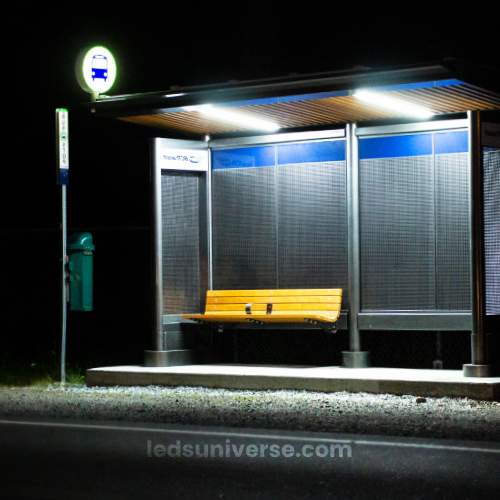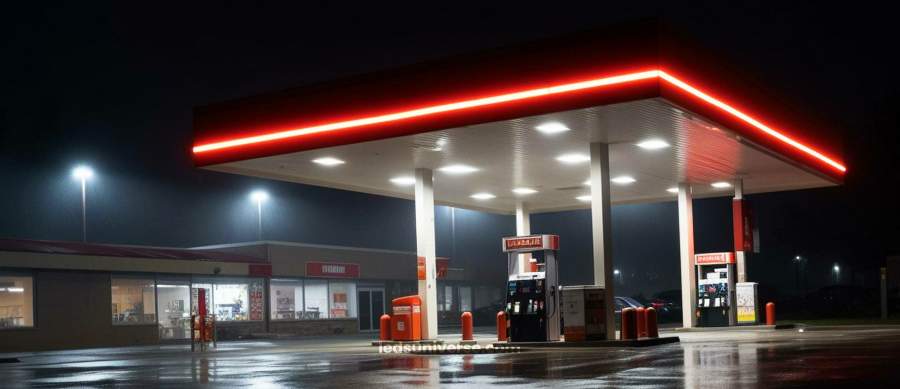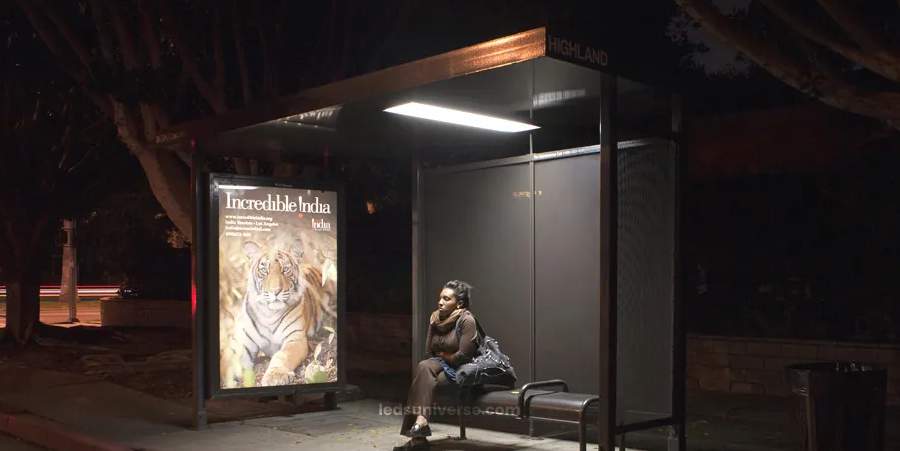Whether it’s a gas station, parking garage, or walkway, the right lighting makes a significant difference. We will explore key aspects of canopy lighting, including lux levels, color temperature, and installation best practices, and highlight why LED technology is a standout choice for creating secure, inviting, and cost-effective spaces.
Key factors include achieving appropriate lux levels to ensure visibility and selecting the right color temperature to match the desired lighting effect. Understanding these design considerations helps create a well-lit environment that is both functional and inviting.
Reach out for free lighting consultation
Table of Contents
Toggle Lux levels are a fundamental aspect of canopy lighting, directly influencing the effectiveness and safety of the illuminated area. Lux measures the amount of light received on a surface, and achieving the correct lux level is crucial for ensuring adequate visibility and reducing hazards. For canopies, the recommended lux levels typically range between 20 to 50 lux.
Lux levels are a fundamental aspect of canopy lighting, directly influencing the effectiveness and safety of the illuminated area. Lux measures the amount of light received on a surface, and achieving the correct lux level is crucial for ensuring adequate visibility and reducing hazards. For canopies, the recommended lux levels typically range between 20 to 50 lux.
For high-traffic areas like gas stations, a higher lux level closer to 50 is often necessary to ensure that both vehicles and pedestrians can move safely and efficiently. In contrast, less busy locations might require lower lux levels. Proper lux levels not only enhance safety but also contribute to a more comfortable and welcoming environment.
Color temperature, measured in Kelvin (K), affects how light appears and its suitability for various applications. In canopy lighting, choosing the appropriate color temperature is vital for both functionality and aesthetic appeal. Generally, a color temperature of 4000K to 5000K is ideal for outdoor settings.
A color temperature of around 4000K provides a neutral white light that is easy on the eyes and suitable for general illumination. This range is often used in environments where a balance between visibility and comfort is required. For areas needing more intense illumination and alertness, such as security-sensitive locations, a color temperature closer to 5000K offers a cooler, daylight-like light that enhances visibility and safety.

The installation of canopy lights involves choosing the right mounting option to ensure optimal performance and durability. Canopy lights can be mounted in various ways, including surface-mounted, recessed, or pendant configurations.
Surface-mounted lights are popular due to their ease of installation and maintenance. They are typically installed directly onto the surface of the canopy, providing straightforward access for repairs or bulb replacements. Recessed mounting, where lights are embedded into the canopy, offers a cleaner appearance and helps reduce glare. Pendant mounting allows for more flexibility in adjusting the light direction, which can be beneficial for customized lighting setups.
Proper height and angling of canopy lights are critical to achieving effective illumination and reducing shadows. The height at which lights are mounted typically ranges from 10 to 15 feet, depending on the size of the canopy and the specific lighting requirements.
Angling the lights appropriately helps to ensure even light distribution and minimizes glare. For instance, in a gas station setting, lights should be angled to cover both the fueling area and the surrounding space without creating dark spots or excessive brightness that could impair visibility.
Effective canopy lighting isn’t just about illuminating a space—it’s about enhancing functionality and creating a welcoming atmosphere. Proper design and placement play a crucial role in achieving these goals. When canopy lights are designed with specific lux levels and color temperatures in mind, they not only improve visibility but also contribute to the overall safety and aesthetic appeal of the area.
An essential aspect of canopy lighting design is the layout and distribution of lights. Evenly distributed lighting helps to eliminate dark spots and ensures consistent illumination across the entire area. This is particularly important in high-traffic areas where uneven lighting can create safety hazards. For example, in a gas station or parking garage, an even distribution of light allows drivers and pedestrians to see clearly, reducing the risk of accidents and enhancing the overall safety of the environment.
The quality of canopy lighting directly affects the customer experience. Bright, well-distributed lighting makes spaces feel more secure and inviting. In commercial settings like gas stations or shopping centers, this can translate into higher customer satisfaction and increased patronage. A well-lit environment encourages customers to visit more frequently and feel more comfortable while on the premises. By investing in quality canopy lighting, businesses can improve their customer service and create a more positive atmosphere.

As environmental concerns become increasingly important, selecting the right canopy lighting also involves considering its ecological impact. LED lights are a clear winner in this regard due to their energy efficiency and reduced carbon footprint. By using less power and generating less heat, LEDs help to lower energy consumption and reduce greenhouse gas emissions. This not only benefits the environment but also aligns with many businesses’ sustainability goals.
Another environmental benefit of LED canopy lights is their reduced waste generation. Unlike traditional bulbs, which often contain hazardous materials like mercury, LEDs are free from such toxins and can be recycled more easily. This helps to minimize environmental impact and supports a more sustainable approach to lighting.
The field of canopy lighting has seen significant technological advancements, particularly with the introduction of smart lighting systems. These systems offer features such as remote control, automatic dimming, and integration with building management systems. Smart lighting not only enhances convenience but also further optimizes energy usage by adjusting light levels based on real-time conditions.
Smart canopy lighting can be integrated with existing building management systems to create a cohesive and efficient lighting strategy. For example, lights can be programmed to adjust based on the time of day, occupancy levels, or ambient light conditions. This integration helps to ensure that lighting is always at optimal levels, improving both safety and energy
Ensuring safety and comfort is a primary concern for any facility utilizing canopy lighting. LED canopy lights are designed with retrofit features that enhance illumination and reduce shadowy areas, thereby improving safety for patrons. Whether at a gas station, a walkway, or a parking garage, LEDs provide bright, accurate lighting that makes environments feel more secure and welcoming. The enhanced visibility offered by LED lights ensures that customers feel safe and comfortable, encouraging them to return and use the facility more frequently.
One of the most significant advantages of LED canopy lights is their durability and longevity. Compared to traditional HID lights, which often require frequent replacements, LED lights can last up to five times longer. This durability is due to their robust design, which includes fewer glass components and greater resistance to high temperatures.
LED lights are built to withstand harsh conditions, making them suitable for a range of business environments. Their longevity and resilience mean fewer replacements and lower maintenance costs, making them a wise investment for facilities aiming for long-term efficiency and cost-effectiveness.
Cost efficiency is a key factor in choosing canopy lighting. LED lights are highly attractive for their low energy consumption and minimal maintenance requirements. Traditional HID fixtures, which once dominated canopy lighting, can consume between 170W to 450W of energy and experience significant lumen output loss over time.
In contrast, LED lights use up to 70% less energy while maintaining consistent brightness levels. This reduction in energy usage not only lowers utility bills but also minimizes the frequency of maintenance and replacement. LEDs also produce very little heat, further enhancing their cost-efficiency and making them a superior choice for modern lighting needs.
LED canopy lights are designed to be user-friendly, simplifying the process of operation and maintenance. They do not require additional staff or specialized knowledge for control. The ease of operation extends to adjusting brightness levels or turning the lights on and off, making them accessible for all users without unnecessary complications.
Beyond their functional benefits, LED canopy lights contribute to the aesthetic appeal of a facility. They provide a bright, clear illumination that enhances the visual attractiveness of spaces like gas stations and walkways. The ability of LED lights to create a warm, inviting glow not only improves safety but also makes the facility more appealing to customers. A well-lit area with modern, attractive lighting can significantly boost the overall image of a facility.
Understanding design considerations such as lux levels and color temperature helps in selecting the right lighting for specific needs. Proper installation and placement are essential for achieving effective illumination and enhancing the safety and comfort of the environment. LED canopy lights stand out for their energy efficiency, durability, and user-friendly nature, making them an excellent choice for modern lighting solutions. By investing in the right canopy lighting, facilities can create safer, more attractive, and cost-effective environments for their patrons.